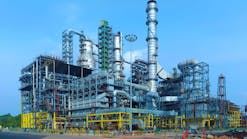Don Stowers,Editor — OGFJ
EDITOR'S NOTE: GE Energy Financial Services (GE EFS), with $23 billion in assets, invests globally across the energy spectrum in capital-intensive oil and gas projects as well as alternative energy such as wind, solar, biomass, and hydroelectric. Managing director James F. Burgoyne met with OGFJ editor Don Stowers and OGFJ publisher Nicole Durham during a recent visit to Houston.
OIL & GAS FINANCIAL JOURNAL: Does GE EFS function somewhat like an equity fund?
JAMES BURGOYNE: Not exactly. The best way I can describe it is that we're very flexible. We invest throughout the capital spectrum. That is a big part in our success all these years. We can provide common equity. We can provide preferred equity. We can provide construction equity. We can provide debt. All these are a part of our investment mix. It's really a function of risk and return, and what the client is looking for at a given point in time. That flexibility gives us a lot of advantages when we're completing transactions because we can mix and match and structure accordingly. We're looking for a return, obviously. We're looking for net income. But we have a lot of flexibility in how we go about it.
OGFJ: Of GE EFS's $23 billion in assets, the firm currently owns $1.5 billion in oil and gas reserves, only about 6.5% of the total. Where is the rest invested?
BURGOYNE: We're invested across all forms of energy. The oil and gas sector has been one of our most successful and profitable, and that capital is continually being deployed. We can invest more, but that's what we have in upstream as of today. We control more than 30,000 miles in natural gas pipelines, and we've put millions of dollars into wind, solar, biomass, hydro, geothermal, and other renewable power projects. We touch most parts of the energy spectrum.
OGFJ: In light of the recent BP disaster in the Gulf of Mexico, do you think it will be more difficult for oil and gas companies operating offshore to access capital, particularly those in deepwater areas?
BURGOYNE: It's definitely going to cause a chill in investments until all the studies have been done and all the rules changes that come from this are known and understood. Until that happens, whether you're a strategic investor or a financial investor, you've got to take pause and see what that means. But, as a company, we are convinced that subsea oil and gas exploration, production, and development are going to continue. It's where the oil is. GE Oil & Gas is spending huge sums of money investing in new technologies for subsea production, so we think it's going to continue for sure. As far as whether or not this accident will affect our investments, I don't think there's that kind of correlation. We have to go where the opportunities are. If there are more opportunities in gas-fired power plants than offshore infrastructure, we are going to have to go there.
OGFJ: Does GE EFS have its own engineers and geologists on staff to perform due diligence where you're looking at investment opportunities in oil and gas?
BURGOYNE: We do. In our upstream oil and gas business, many of our folks are petroleum engineers or reservoir engineers. They've crossed over to the finance side at some point in their careers. It's a great mix to have within your group because it's all about experience and expertise. We do use external consultants as well, depending on our needs, but we have a solid professional staff whether it's for power, renewables, or oil and gas.
OGFJ: Final question: How attractive is shale gas and oil among upstream investment opportunities?
BURGOYNE: Very attractive. It's driving a tremendous amount of transaction activity. We've seen a high-quality stream of new acquisitions and investment opportunities with our partners. Companies are selling their conventional oil and gas reserves to raise the capital to supplement their own liquidity to drill up their shale plays, wherever they are — Haynesville, Eagle Ford, you name it. They're selling off "non-core" assets, but to us and our partners, they're great assets. That's one way shale has impacted us. The other way is that we see new opportunities in building infrastructure — transmission, gathering, services, etc. For now, we'd rather pursue this than upstream projects [in shale plays] due to the fact that information about reserves, production, and decline rates are still not widely known.
More Oil & Gas Financial Journal Current Issue Articles
More Oil & Gas Financial Journal Archives Issue Articles
View Oil and Gas Articles on PennEnergy.com



